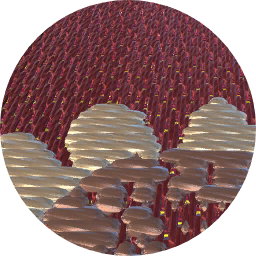1851, Saffron Walden
1851, Saffron Walden
- Identifier
- T.45-1964
- Acquisition
- Given by Mrs G. Wraith
- Carried out by
- Cunliffe, Sarah Ann (http://data.silknow.org/activity/designer)
- Collection
- Technique
- Embroidery 100%
- Embroidery 99%
- Embroidery 86%

- Embroidery 95%
- Depiction
- Vegetal motif 59%

- Vegetal motif 59%
- Dimension
- 62 cm (height)60 cm (width)
- Production time
- Production place
- Type of object
Description
This extraordinary baby's gown won third prize in the handknitting section of the Great Exhibition. It is important not only as a superb example of needlework skill, but also because the precise details of its making have survived.
Materials & Making
The gown is worked in leaf and diamond patterns with scallops at the hem and neck. It would have been knitted on extremely fine needles. These patterns of open stitches are similar to those of the knitted Shetland 'lace' shawls popular in the 1840s.
Historical Associations
One of the strengths of the Great Exhibitions was its liberal attitude to both machine and handmade objects. Each method had its advantages and beauties; the Great Exhibition welcomed all media. Hand knitting featured prominently in the knitwear section of the Great Exhibition. It was seen as an artistic craft and the submissions displayed great virtuosity in materials and design. Some of the more unusual entries included a knitted landscape, a shawl knitted with a prayer for the Houses of Parliament, and a pair of cuffs, hand-spun and knitted from the wool of French poodles.
In the mid-19th century, hand knitting was considered a very useful skill for the poorer members of society. Knitting, along with other needle arts, was taught in orphanages and poor houses. A number of the hand knitting submissions to the Great Exhibition were from children and disabled adults and were noted for the remarkable proficiency they demonstrated. British Galleries: MEDAL-WINNING BABY'S GOWN
Handknitting featured prominently in the knitwear section. It was seen as an artistic handcraft which displayed great virtuosity in materials and design. Miss Sarah Ann Cunliffe knitted this dress which won the bronze medal for its class. It was made with 1« million stitches and 6,300 yards of sewing cotton. [27/03/2003] 6. BABY'S DRESS Hand-knitted cotton English, 1851 This delicate lacy dress, made with 1,464,859 stitches and 6,000 yards of no.100 sewing cotton, was exhibited at the Great Exhibition of 1851 where it was awarded a bronze medal. It was knitted by Miss Sarah Ann Cunliffe of Saffron Walden, who worked seven hours a day for five months to complete it. Given by Mrs G. Wraith T.45-1964 [1985] Baby's dress of hand-knitted cotton thread, made by Sarah Ann Cunliffe, Saffron Walden, 1851 Baby's dress of hand-knitted cotton thread with a wide neck edged with a straight scalloped border in a diamond pattern, straight sleeves to match, bodice with a triangular panel of lozenge diaper pattern and a band of diamond pattern in the front, opening at the back and fastens with four pearl buttons, and with a gathered long skirt. The skirt has a central panel of vertical stripes in a formalised leaf pattern, and the rest is worked in a lozenge diaper pattern with four bands of a fancy diamond pattern. Border round the bottom of the skirt matches that round the neck. Lined with red silk.



